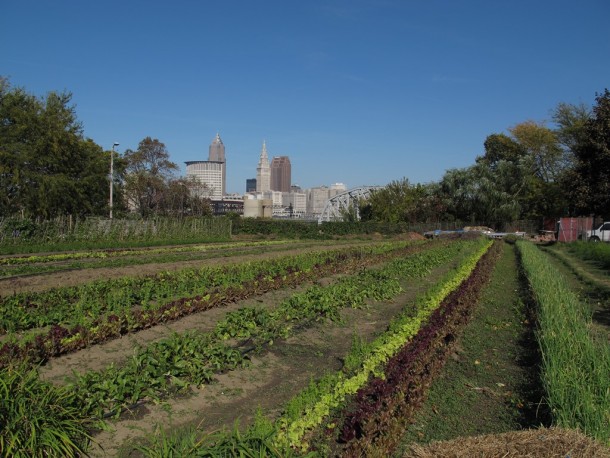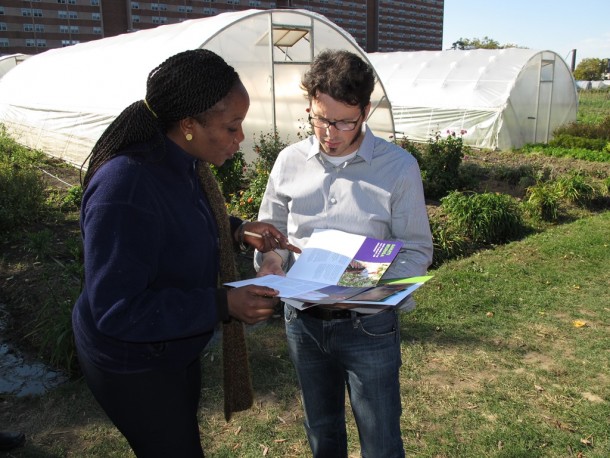Can an urban farm help solve the refugee crisis?
 Oxfam and Refugee Response staff pose with refugees who are part of the REAP urban farming program. Credit: Oxfam America
Oxfam and Refugee Response staff pose with refugees who are part of the REAP urban farming program. Credit: Oxfam America
A project in Cleveland uses farming to help refugees resettle.
My worlds collided a bit during a recent visit to Cleveland. I was there to talk about Oxfam’s awesome Female Food Hero project in Nigeria. But while there, we were invited to take a tour of a unique urban farm that uses farm employment to help refugees resettle.

The farm is beautiful and sits under the Cleveland skyline in a hip neighborhood, a stone’s throw from Great Lakes Brewing Company and the West Side Market which is the city’s largest tourist attraction. (Take that, Rock & Roll Hall of Fame!)
Urban farming is a trending idea both in the USA and internationally. Making productive use of underutilized urban and peri-urban land is an important idea and could make a major contribution to food security and developing resilient and localized food systems.
But this urban farm is also being used as an employer for newly resettled refugees from around the world and an anchor for skills-building and education. The project is called Refugee Empowerment Agricultural Program (REAP) and is run by a local organization, The Refugee Response. REAP has community-supported agriculture and provides produce for a farm stand and supplies local restaurants (including the Great Lakes Brewing Company, which has been a supporter).

I had a chance to chat with Darren Hamm the Executive Director of The Refugee Response.
Q: This is an interesting model – but it’s still pretty small in the scheme of things, right? Why hasn’t this been replicated elsewhere and scaled up? Are there natural constraints or obstacles?
A: That’s right. We’re currently employing 9 farm trainees on 6 acres in northeast Ohio. But the world that we work in requires us to focus on depth as opposed to breadth. We are very conscious of how much more work we could do and how many more we could be benefitting, but want to make sure that we are doing the best possible with what we have. While we are not the first organization to connect newcomers around agriculture, we are more unique in that we put our education and support services front and center. Doing this at scale to meet the current demand would require land and capital (human and financial), a suitable network of vendors and customers to purchase produce, and an environment that welcomes graduates to the workforce. It’s absolutely possible.
Q: Working with refugees and utilizing some the skills and experiences they already have – farming and gardening – is a great idea. But farming and farm labor are pretty risky and low-paid careers. Shouldn’t we be trying to track them into better jobs and incomes?
A: That’s a good point, and I often have to clarify that we are not necessarily raising farmers. We are using this as a place to meet when we have little else, like language, in common. This platform provides for time to build the skills necessary to graduate and enter the world of gainful employment. And while this may mean remaining part of the food industry, like in farming, food production or retail, it may likely be in a variety of other industries. Our goal remains to enroll low and exit high, growing from early employment opportunities to more gainful, longer-term positions.
Q: Oxfam has been arguing that the US and other advanced countries should be taking in a lot more refugees, especially from Syria and other conflicts. But you’re on the other end of that chain. Do you think it’s a good idea? Feasible?
A: I would support welcoming any refugee from any region of the world. But in order to create a positive environment for our newest community members, we would need a significant investment in the resettlement infrastructure; suitable housing, education systems that can meet the needs of learners young and old, and employment opportunities among others. An increase is feasible, but only if it is grown over time. We should never expect to increase the number of refugees we accept annually only to tax existing systems and risk failing these wonderful people.
Q: How did you get into this work? What’s the fun part? What’s the part that drives you crazy?
A: I should have left the trail of breadcrumbs! There is too much work to look backwards and try and re-trace the steps. I do feel that it’s part of my calling, especially as someone who has travelled extensively and found myself in the service of others. The fun part: how I get to be part of the story, even if for only a time, of those we serve. The part that drives me crazy: time, money and the lack of both.